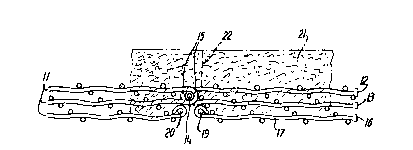Une partie des informations de ce site Web a été fournie par des sources externes. Le gouvernement du Canada n'assume aucune responsabilité concernant la précision, l'actualité ou la fiabilité des informations fournies par les sources externes. Les utilisateurs qui désirent employer cette information devraient consulter directement la source des informations. Le contenu fourni par les sources externes n'est pas assujetti aux exigences sur les langues officielles, la protection des renseignements personnels et l'accessibilité.
L'apparition de différences dans le texte et l'image des Revendications et de l'Abrégé dépend du moment auquel le document est publié. Les textes des Revendications et de l'Abrégé sont affichés :
| (12) Brevet: | (11) CA 1313341 |
|---|---|
| (21) Numéro de la demande: | 1313341 |
| (54) Titre français: | TISSU POUR MACHINE A PAPIER |
| (54) Titre anglais: | PAPERMACHINE CLOTHING |
| Statut: | Périmé et au-delà du délai pour l’annulation |
| (51) Classification internationale des brevets (CIB): |
|
|---|---|
| (72) Inventeurs : |
|
| (73) Titulaires : |
|
| (71) Demandeurs : |
|
| (74) Agent: | NORTON ROSE FULBRIGHT CANADA LLP/S.E.N.C.R.L., S.R.L. |
| (74) Co-agent: | |
| (45) Délivré: | 1993-02-02 |
| (22) Date de dépôt: | 1988-03-28 |
| Licence disponible: | S.O. |
| Cédé au domaine public: | S.O. |
| (25) Langue des documents déposés: | Anglais |
| Traité de coopération en matière de brevets (PCT): | Non |
|---|
| (30) Données de priorité de la demande: | ||||||
|---|---|---|---|---|---|---|
|
ABSTRACT
PAPERMACHINE CLOTHING
The invention is concerned with a base fabric for use in
the manufacture of a papermachine press-felt, the base fabric
comprising a multi-layer endless woven fabric wherein the machine
direction yarns of at least one fabric layer form interdigitated weft
loops having a warp yarn therein, and thus define a seam, and
wherein at least one further fabric layer exists. The further layer
or layers may be continuous throughout the full longitudinal extent
of the multilayer fabric, and are slit along the line of the seam
after needling of a batt to the base fabric, or may be broken and
the weft yarns woven tight about an extreme warp yarn.
Note : Les revendications sont présentées dans la langue officielle dans laquelle elles ont été soumises.
Note : Les descriptions sont présentées dans la langue officielle dans laquelle elles ont été soumises.

2024-08-01 : Dans le cadre de la transition vers les Brevets de nouvelle génération (BNG), la base de données sur les brevets canadiens (BDBC) contient désormais un Historique d'événement plus détaillé, qui reproduit le Journal des événements de notre nouvelle solution interne.
Veuillez noter que les événements débutant par « Inactive : » se réfèrent à des événements qui ne sont plus utilisés dans notre nouvelle solution interne.
Pour une meilleure compréhension de l'état de la demande ou brevet qui figure sur cette page, la rubrique Mise en garde , et les descriptions de Brevet , Historique d'événement , Taxes périodiques et Historique des paiements devraient être consultées.
| Description | Date |
|---|---|
| Inactive : CIB de MCD | 2006-03-11 |
| Inactive : CIB de MCD | 2006-03-11 |
| Inactive : CIB de MCD | 2006-03-11 |
| Le délai pour l'annulation est expiré | 2003-02-03 |
| Lettre envoyée | 2002-02-04 |
| Lettre envoyée | 2001-03-29 |
| Accordé par délivrance | 1993-02-02 |
Il n'y a pas d'historique d'abandonnement
| Type de taxes | Anniversaire | Échéance | Date payée |
|---|---|---|---|
| TM (catégorie 1, 5e anniv.) - générale | 1998-02-02 | 1998-02-02 | |
| TM (catégorie 1, 6e anniv.) - générale | 1999-02-02 | 1999-02-02 | |
| TM (catégorie 1, 7e anniv.) - générale | 2000-02-02 | 2000-02-01 | |
| TM (catégorie 1, 8e anniv.) - générale | 2001-02-02 | 2001-01-31 | |
| Enregistrement d'un document | 2001-02-09 |
Les titulaires actuels et antérieures au dossier sont affichés en ordre alphabétique.
| Titulaires actuels au dossier |
|---|
| VOITH FABRICS HEIDENHEIM GMBH & CO. KG |
| Titulaires antérieures au dossier |
|---|
| ALAN GREEN |
| BRIAN RILEY |